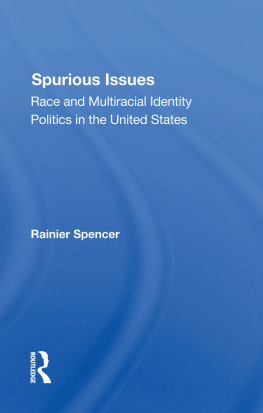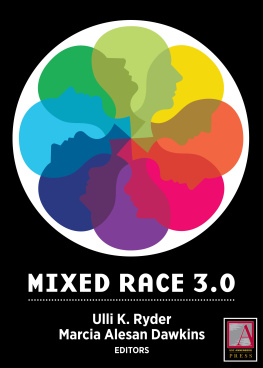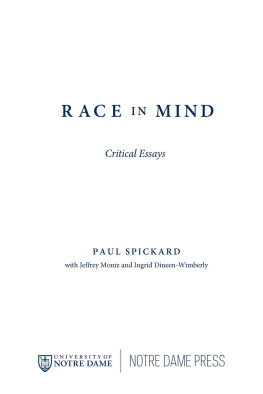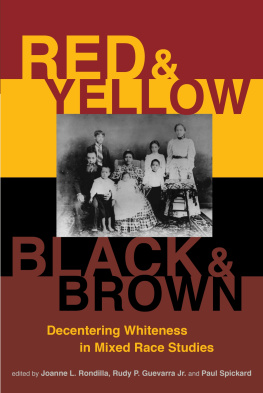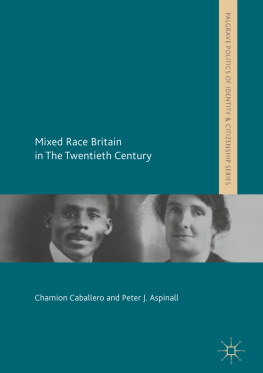Thank you for buying this ebook, published by NYU Press.
Sign up for our e-newsletters to receive information about forthcoming books, special discounts, and more!
Sign Up!
About NYU Press
A publisher of original scholarship since its founding in 1916, New York University Press Produces more than 100 new books each year, with a backlist of 3,000 titles in print. Working across the humanities and social sciences, NYU Press has award-winning lists in sociology, law, cultural and American studies, religion, American history, anthropology, politics, criminology, media and communication, literary studies, and psychology.
THE NEW COLORED PEOPLE
Jon Michael Spencer
with a Foreword by
Richard E. van der Ross
THE NEW COLORED PEOPLE
The Mixed-Race Movement in America
NEW YORK UNIVERSITY PRESS
New York and London
1997 by Jon Michael Spencer
All rights reserved
Library of Congress Cataloging-in-Publication Data
Spencer, Jon Michael.
The new colored people: the mixed-race movement in America / Jon
Michael Spencer; with a foreword by Richard E. van der Ross.
p. cm.
Includes bibliographical references and index.
ISBN 0-8147-8071-7 (alk. paper)
1. Racially mixed peopleUnited States. I. Title.
E184.A1S7 1997 96-45791
973.04dc21 CIP
New York University Press books are printed on acid-free paper, and their binding materials are chosen for strength and durability.
Manufactured in the United States of America
10 9 8 7 6 5 4 3 2 1
TO
NICOLE WALIGORA
[FOREWORD]
Over thirty years ago (I believe it was the year 1962), I had the honor of sharing a platform with Dr. Martin Luther King, Jr. In the course of my remarks, I told the audience that we, the oppressed in South Africa, were watching the American civil rights movement closely. I stated rather dramatically: If you succeed, we can succeed; if you fail, we will fail. Little did I think that over thirty years later a black American would be saying to the people of South Africa: We in the United States need to learn from you, for we want to replicate your successes and not your mistakes of history.
In this book, the result of the authors inquiries into South African history, bold, frontal attention is given to a highly sensitive and very complex issuethe mixed-race or multiracial movement in the United States. This is a movement led by interracial parents and mixed-race people who are dissatisfied with the current racial classifications and seek to have a new racial category added to the existing four. They argue that mixed-race people are multiracial, and they have petitioned the United States government to add multiracial to the federal census. In developing his position against legislating a new racial classification, the author draws parallels between the would-be multiracial group in America and the Coloured people of South Africa.
But most of all, Professor Spencer argues that Americans are uninformed about the tragic consequences of the former white South African government legally classifying all mixed-race people as Coloureds. Oddly enough, the American multiracials are requesting to be legally classified, whereas South Africas mixed-race people have never made such a request. We just slid into the position of an intermediary category, having the classification of Coloured semilegislated after the emancipation of slaves in 1834, and having it further legislated to our disadvantage in 1948.
Where do I stand with regard to the idea of the United States government establishing a category of multiracial? Having weighed the authors arguments for and against, and having considered the historical situation of the Coloured people of South Africa, I concur with the authors position: While I have great respect for the multiracials striving to strengthen their mixed-race identity and to obliterate their societal invisibility, it is an inescapable fact that the legal classification of Coloured provided the lever for the white South African government to introduce all manner of discrimination against the group once it was legally identified.
It is true that a sense of mixed-race identity could be a powerful factor in raising the awareness of all mixed-race people; but it is also true that if raised to the status of a legal category, that which is well intentioned could become a tragedy. This may appear to leave the American people at an impasse, but from this book Americans can walk away with an informed resolution of this quandary.
RICHARD E. VAN DER ROSS
Cape Town, South Africa
[PREFACE]
Most Americans are rather oblivious to the fact that there is a new racial movement silently shifting the earth beneath their feet as they walk confidently toward the twenty-first century. We may have seen some mention of this movement in the media, particularly the struggle of interracial parents in local school systems that have refused to permit their children to claim a mixed racial background on school forms. However, most of us are hardly aware that a good number of these same parents, out of frustrations regarding the identity and treatment of their mixed-race children, have begun a movement to see a classification of multiracial added to the United States census.
Legislating a new classification and thereby establishing a new race could have a profound effect on race relations in this country and therefore affect the lives of us all. But whether or not my alarm is accurate, and whether or not the new classification is adopted for the census of 2000 or 2010, I want to confront the multiracialists (the staunch advocates of the multiracial identity) on their racial logic. Chief among these multiracialists I hope to challenge are the interracial parents of mixed-race children. These multiracialists are, for reasons I will explain in , the real backbone behind the multiracial movement.
The issue I will discuss in this book may also be of interest to whites (not just those in interracial marriages), for it will confront them with some of the issues they may think about when they run across interracial families: the ethicality of such relationships, the status of the offspring of interracial unions, the question of who is and is not black or white, and the uncertainty of whether or not to allow people with partial white ancestry to increase their proximity to whites through a mixed-race classification.
In addition, this book is written for all black Americans, those 29.9 million who comprise 12 percent of the 250 million citizens in this country. This book should interest the nations black citizenry (of which I am a member) because officials of the United States Bureau of the Census estimate that at least 75 percent of the black population are ancestrally multiracial. At present, only a small percentage of the black population, those of immediate mixed-race parentage, would be considered mixed race by the multiracialists heading the multiracial movement. But in the future, in the census of 2010 or 2020, that could change.
Finally, in this book I am pushing for an answer to the question historian Joel Williamson raises in the closing pages of New People: Miscegenation and Mulattoes in the United States (1980). Williamson says that American blacks, at that time numbering around 22 million, constitute one of the largest communities of blacks outside of Africa and are the richest, probably the most powerful in the world, and are here to stay. The only question is, he asks, in what manner shall they stay? Williamson continues with his prophecy of the year 2000:


